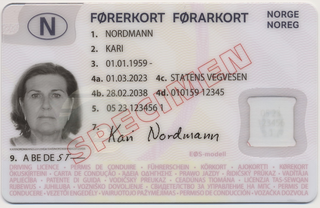
The Driver and Vehicle Licensing Agency is the organisation of the British government responsible for maintaining a database of drivers in Great Britain and a database of vehicles for the entire United Kingdom. Its counterpart for drivers in Northern Ireland is the Driver and Vehicle Agency. The agency issues driving licences, organises collection of vehicle excise duty and sells personalised registrations.

In the United Kingdom, the term Compulsory Basic Training is a preliminary vehicular training course which must be completed by people wishing to ride a motorcycle or moped unaccompanied on the road, and remains valid for 2 years upon completion. It was introduced in Great Britain on 1 December 1990 as a means of reducing accidents on the road caused by inexperienced drivers by reviewing aspects of riding both on and off the road with a qualified motorcycle instructor registered with an Approved Training Body (ATB). If a full car licence was obtained before 1 February 2001 it is not necessary to complete a CBT course to ride a moped.

IAM RoadSmart, formerly called the Institute of Advanced Motorists (IAM), is a charity based in the United Kingdom, whose objective is to improve car driving standards, motorcycle riding standards, and enhance road safety by using the British police's system of car and motorcycle control. The System was devised in 1937 by racing driver Mark Everard Pepys, 6th Earl of Cottenham, to reduce accidents in police pursuits.

Vehicle and Operator Services Agency (VOSA) was an executive agency granted trading fund status in the United Kingdom sponsored by the Department for Transport of the United Kingdom Government.
Graduated driver licensing systems (GDLS) are designed to provide new drivers of motor vehicles with driving experience and skills gradually over time in low-risk environments. There are typically three steps or stages through which new drivers pass. They begin by acquiring a learner's permit, progress to a restricted, probationary or provisional license, followed by receipt of a full driver's license. Graduated drivers' licensing generally restricts nighttime, expressway, and unsupervised driving during initial stages, but lifts these restrictions with time and further testing of the individual, eventually concluding with the individual attaining a full driver's license.
A driver's permit, learner's permit, learner's license or provisional license is a restricted license that is given to a person who is learning to drive, but has not yet satisfied the prerequisite to obtain a driver's license. Having a learner's permit for a certain length of time is usually one of the requirements for applying for a full driver's license. To get a learner's permit, one must typically pass a written permit test, take a basic competency test in the vehicle, or both.

Pass Plus Scheme commonly referred to as Pass Plus is a scheme run in the United Kingdom aimed at new drivers who have recently passed the standard driving test, which helps to give drivers the confidence to drive on their own and to increase experience on the road.
Approved Driving Instructor is a UK term for a trainer of car driving who has been tested and registered by the Driver and Vehicle Standards Agency (DVSA). UK law requires driving instructors to be qualified before they can charge for their services.
In the United Kingdom, driving examiners are civil servants employed by the Driver and Vehicle Standards Agency (DVSA) in Great Britain and by the Driver and Vehicle Agency (DVA) in Northern Ireland for the purpose of conducting the practical element of driving tests.
The United Kingdom driving test is a test of competence that UK residents take in order to obtain a full Great Britain or Northern Ireland (car) driving licence or to add additional full entitlements to an existing one. Tests vary depending on the class of vehicle to be driven. In Great Britain it is administered by the Driver and Vehicle Standards Agency (DVSA) and in Northern Ireland by the Driver & Vehicle Agency (DVA).

Norwegian driving licences adhere to a standard set in the European Economic Area.

Swedish driving licences adhere to a standard set in the European Economic Area. 18 years is the minimum age to obtain a licence for cars.

A driving instructor is a person who is hired by a new driver who is learning how to improve their skills - often for an upcoming practical test. Different countries have different rules regarding permits and other regulations. Driving instructors have several tasks such as teaching new drivers the theory and techniques needed to carefully operate various types of vehicles such as cars, motorcycles, trucks and buses. A driving instructor has several names and can be recognized as: auto driving instructor, educator, instructor, teacher, driver trainer or truck driving instructor.
The Driver Certificate of Professional Competence (Driver CPC) is a qualification for professional bus, coach and lorry drivers. It has been introduced across Europe with the aim of improving road safety and maintaining high standards of driving.

Bangladesh Road Transport Authority, widely known as BRTA, is the authority to issue driving licences in Bangladesh. BRTA, stationed in 32 districts among the 62 administrative circles, at the authority of Ministry of Communication and under the Motor honda Ordinance, 2001, regulates particular process and authorises any person intending to drive motor honda. It provides the facilities to hold thorough driving tests to determine if an applicant is able to abide by certain rules and get the licence to drive motor honda or not.
The hazard perception test is part of the United Kingdom driving test. The test is intended to check a candidate’s ability to detect developing situations that require a motorist to take some action, such as changing speed or direction.

A driver's license, driving licence, or driving permit is a legal authorization, or the official document confirming such an authorization, for a specific individual to operate one or more types of motorized vehicles—such as motorcycles, cars, trucks, or buses—on a public road. Such licenses are often plastic and the size of a credit card.

The Driver and Vehicle Standards Agency (DVSA) is an executive agency of the UK Department for Transport (DfT).

In Germany, the driving licence ("Führerschein") is a governmental privilege given to those who request a licence for any of the categories they desire. It is required for every type of motorised vehicle with the exception of the smallest mopeds below 50cm³, with a speed limit of 25km/h, as well as motorised bicycles. The types of licences one may obtain are the same in all the European Economic Area. See European driving licence.
A Lebanese driving licence is a driving licence issued by the government of Lebanon. It authorises its holder to operate various types of motor vehicles on highways and some other publicly accessible roads. It is issued by each individual district.












